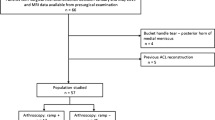Abstract
Objective
To identify the findings on magnetic resonance imaging most strongly associated with meniscal ramp lesions in patients with an anterior cruciate ligament tear.
Subjects and methods
Seventy-eight consecutive patients (mean age, 33.7 years; 64 male, 14 female) with an arthroscopically proven anterior cruciate ligament tear were included in this retrospective study. The presence of the following six features on magnetic resonance images were recorded: complete fluid filling between the posterior horn of the medial meniscus and the capsule margin; edema affecting the posterior capsule; irregularity of the medial meniscus at the posterior margin; fluid at the periphery of the medial meniscus; the corner notch sign; and a vertical tear at the medial meniscus. Findings at arthroscopy served as the reference standard. Diagnostic accuracy, sensitivity, and interobserver agreement were calculated.
Results
Seven ramp lesions were noted on arthroscopy (9%). Findings of irregularity at the posterior margin (p = 0.001) and complete fluid filling between the posterior horn of the medial meniscus and the capsule margin (p = 0.004) on magnetic resonance imaging were significantly associated with the presence of a ramp lesion. With the irregularity at the posterior margin, sensitivity was 86% and specificity was 79%. Complete fluid filling sign showed sensitivity of 57% and specificity of 92%. Concordance of the two readers for the six magnetic resonance imaging features was fair to very good (k = 0.38–0.91).
Conclusions
Irregularity at posterior margin and complete fluid filling were most sensitive findings for detecting of a ramp lesion on magnetic resonance imaging.







Similar content being viewed by others
References
Chahla J, Dean CS, Moatshe G, et al. Meniscal ramp lesions: anatomy, incidence, diagnosis, and treatment. Orthopaedic Journal of Sports Medicine. 2016;4:2325967116657815.
Smith JP, Barrett GR. Medial and lateral meniscal tear patterns in anterior cruciate ligament-deficient knees. Am J Sports Med. 2001;29:415–9.
Strobel MJ. Manual of arthroscopic surgery. Berlin: Springer Science & Business Media; 2013.
Sonnery-Cottet B, Conteduca J, Thaunat M, Gunepin FX, Seil R. Hidden lesions of the posterior horn of the medial meniscus: a systematic arthroscopic exploration of the concealed portion of the knee. Am J Sports Med. 2014;42:921–6.
Thaunat M, Fayard JM, Guimaraes TM, Jan N, Murphy CG, Sonnery-Cottet B. Classification and surgical repair of ramp lesions of the medial meniscus. Arthroscopy Techniques. 2016;5:e871–5.
Ahn JH, Bae TS, Kang K-S, Kang SY, Lee SH. Longitudinal tear of the medial meniscus posterior horn in the anterior cruciate ligament–deficient knee significantly influences anterior stability. Am J Sports Med. 2011;39:2187–93.
Pfeiffer TP, Murphy CI, Arner JW, Musahl V. Identification and treatment of RAMP lesions in anterior cruciate ligament-injured knees. Annals of Joint. 2017;2:17.
Liu X, Feng H, Zhang H, Hong L, Wang XS, Zhang J. Arthroscopic prevalence of ramp lesion in 868 patients with anterior cruciate ligament injury. Am J Sports Med. 2011;39:832–7.
Bollen S. Posteromedial meniscocapsular injury associated with rupture of the anterior cruciate ligament. Bone & Joint Journal. 2010;92:222–3.
Hash TW. Magnetic resonance imaging of the knee. Sports Health. 2013;5:78–107.
Rubin DA, Britton CA, Towers JD, Harner CD. Are MR imaging signs of meniscocapsular separation valid? Radiology. 1996;201:829–36.
De Maeseneer M, Lenchik L, Starok M, Pedowitz R, Trudell D, Resnick D. Normal and abnormal medial meniscocapsular structures: MR imaging and sonography in cadavers. AJR Am J Roentgenol. 1998;171:969–76.
Landis JR, Koch GG. An application of hierarchical kappa-type statistics in the assessment of majority agreement among multiple observers. Biometrics. 1977:363–74.
Edgar C, Ware J, Obopilwe E, Ziegler C, Reed D, Arciero R. Posteromedial meniscocapsular tear: prevalence, detection sensitivity, biomechanics, and repair technique. Available online: [Accessed October 13, 2016]. http://aaos2015.conferencespot.org/58906-aaos-1.1965581/t004–1.1971711/f004–1.1971712/a096–1.1971713/se81–1.1971728 2016.
Arner JW, Herbst E, Burnham JM et al. MRI can accurately detect meniscal ramp lesions of the knee. Knee Surgery, Sports Traumatology, Arthroscopy 2017:1–6.
Author information
Authors and Affiliations
Corresponding author
Ethics declarations
Conflict of interest
The authors declare that they have no conflicts of interest.
IRB statement
This study was approved by the institutional review board of Seoul National University Bundang Hospital.
Rights and permissions
About this article
Cite this article
Yeo, Y., Ahn, J.M., Kim, H. et al. MR evaluation of the meniscal ramp lesion in patients with anterior cruciate ligament tear. Skeletal Radiol 47, 1683–1689 (2018). https://doi.org/10.1007/s00256-018-3007-4
Received:
Revised:
Accepted:
Published:
Issue Date:
DOI: https://doi.org/10.1007/s00256-018-3007-4




